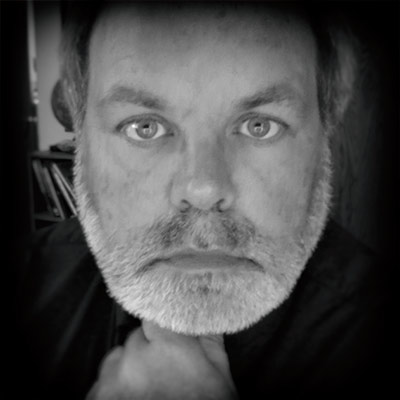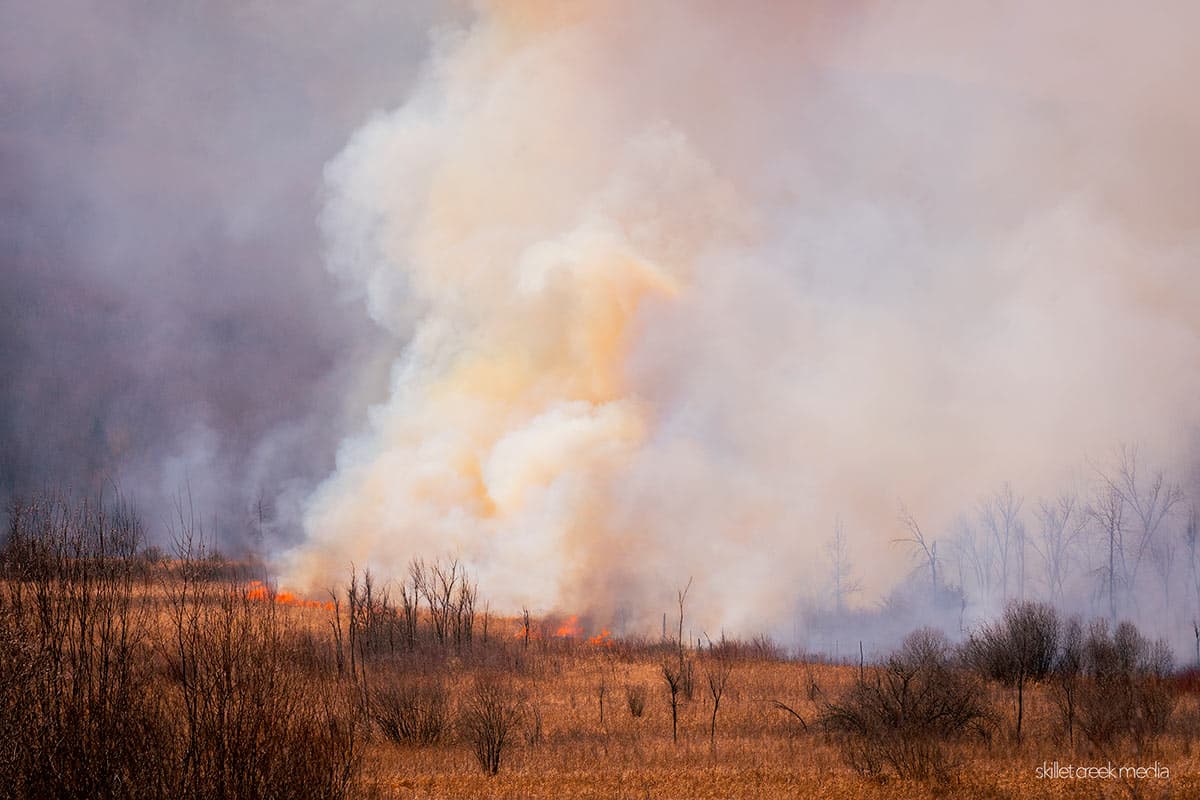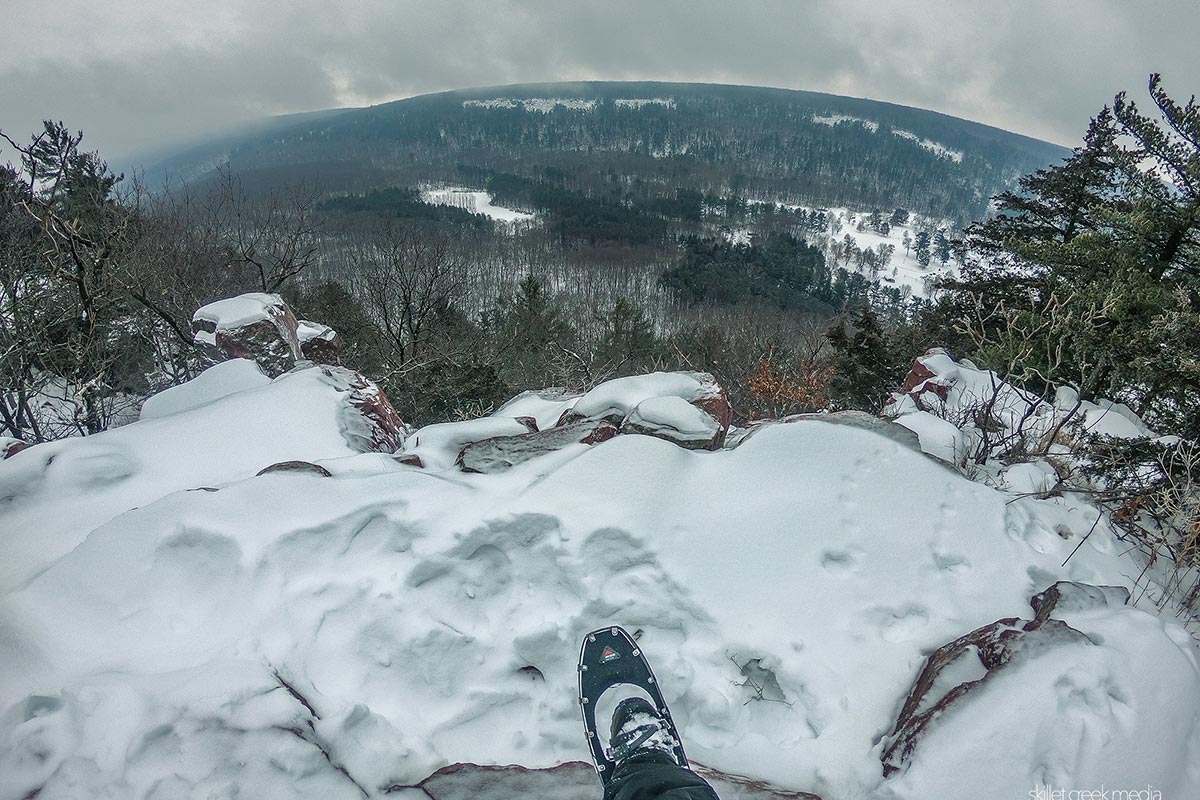Severe storms rolled through our area yesterday afternoon, but fortunately, there wasn’t too much damage…

Author & environmentalist, Edward Abby wrote that the “idea of wilderness needs no defense, it only needs defenders.”. Today, especially here in Wisconsin, the “pristine” wilderness he spoke of is mostly long gone. Our land, even our parks such as here at Devil’s Lake State Park, bear little resemblance to the wilderness that once was revered by indigenous people and awestruck early explorers. And yet, this wilderness, such as it is, still needs defenders today.
I went out snowshoeing yesterday on Devil’s Lake State Park’s south-east corner. This area is known as “Roznos Meadow“, named after the family who farmed this land for many years. I took the photo above while snowshoeing through the prairie. It is a beautiful area! It’s natural and could be called a wilderness with no sign of humans. Well, other than the Ice Age Trail which cuts through the northern corner of the meadow. Yet, looks are deceiving.
Doomed to Repeat It
About a month ago, a news headline was making the social media rounds; “Young people can’t remember how much more wildlife there used to be”. Personally I think very few of us are surprised by that. Humans struggle to appreciate what came before them, after all, we weren’t there. And yet, we must be able to acknowledge what was and learn from it. As Winston Churchill once paraphrased, “Those who fail to learn from history are condemned to repeat it. This is why education is so important.
Living In The Past
There was a time when Wisconsin skies were darkened by now-extinct passenger pigeons and flocks of sandhill and whooping cranes. (Happily, the Sandhills are roaring back!) The wetlands east of Baraboo were home to herds of elk according to early surveyors. Devil’s Lake State Park was once home to healthy populations of wolves, bears, cougars, fisher, and beaver. Today things are much different. Other than the surprising odd straggler, they’re all pretty much gone.
Natural sounds are also disappearing from the forest and wetlands. Around the world, bird population are dropping fast. Even standing deep in Devil’s Lake State Park’s “wild” areas, you are most likely to hear distant traffic, planes overhead or the rumble of a passing train at the foot of the bluffs.
Yes, you can still see deer and raccoons in abundance. (Our trail cameras attest to that!) If you’re lucky you’ll hear coyotes calling at sunset. Tracks of these along with squirrels, rabbits, a mouse or a vole are common out in the snow. But today, with a short walk in the woods, you’ll also discover deer ticks who’s population explosion speaks to spreading invasive plants such as Japanese barberry and the imbalances between predators and prey.
The Consequences of Blindness
And what about the plants? It’s still pretty. Beautiful even! Yes, it is! So where’s the problem? Well, conservationist, Aldo Leopold addressed this in his famous book, “A Sand County Almanac”. He said;
“One of the penalties of an ecological education is that one lives alone in a world of wounds. Much of the damage inflicted on land is quite invisible to laymen. An ecologist must either harden his shell and make believe that the consequences of science are none of his business, or he must be the doctor who sees the marks of death in a community that believes itself well and does not want to be told otherwise.”

As I mentioned, much of this land had been farmed. Even the thick forests on the hillsides are not really natural but a result of settlement. Although some land has been occasionally burned in an attempt to restore some prairie, the wetlands are filled with invasive shrubs and grasses. More recently, oak plantations such as those in Roznos Meadow were planted but seemingly forgotten and never thinned. But yes, it does look pretty to most of us. (Me too if I don’t think about it.) We simply can’t see the underlying damage or perceive the consequences. And like frogs in a frying pan, we don’t really notice the rising heat. And we don’t know what we’re missing or maybe worse, what we’re creating.
Beauty is in the Eye of the Beholder
In the end, it’s beautiful out there! The fresh snow, rolling hills, golden grasses, and red dogwoods inspire and refresh the soul! Still, I’m asking you to pause and think about this; It’s not what it was. Not even close. If we can’t conceive of the vibrant and diverse wilderness of yesterday; If we can’t see the issues today; What will it look like tomorrow? Are we the frog? Will each generation suffer increasing blindness? Dare I say, “lowered expectations?? If so, who cares then, if we build a few more parking lots, clear trees for more lumber sales or put in more massive buildings? Who’ll even notice or care in 20 years? No bigs, sell more t-shirts!
If we want to believe that Devil’s Lake State Park is so popular that “they’ll always come”, and we needn’t put much thought into protecting or restoring the natural environment, Let’s hope that our children and grandchildren, never realize what they missed either and that the beauty of their past, always remains just as invisible.

For nearly 2 decades the Skillet Creek blog has focused on 3 main goals; To inspire you to visit and explore the Devil’s Lake region, to help you get the most your visit by sharing tips, events, and other helpful information. Lastly to advocate for our environment & wildlife and talk about how we can keep our natural areas amazing now and into the future! That last goal can sometimes cause controversy, but it’s the only way we can accomplish the first two. – Derrick Mayoleth, Owner.
Comments (1)
Comments are closed.




Well, it may be said that there’s “absolute” wilderness and “relative” wilderness.
Roznos Meadow may be beyond “absolute” since it isn’t surrounded by enough true wilderness to matter. It may be “wild” if enough time and work was put into it, or it may be “as wild as it can get” within it’s limitations.
It certainly is beautiful. And we can learn the differences between “absolute” and “relative” wilderness. So can we improve on our knowledge of that and hence the difference we can make there if we wish. It will enrich not only ourselves, but Roznos Meadow as well.